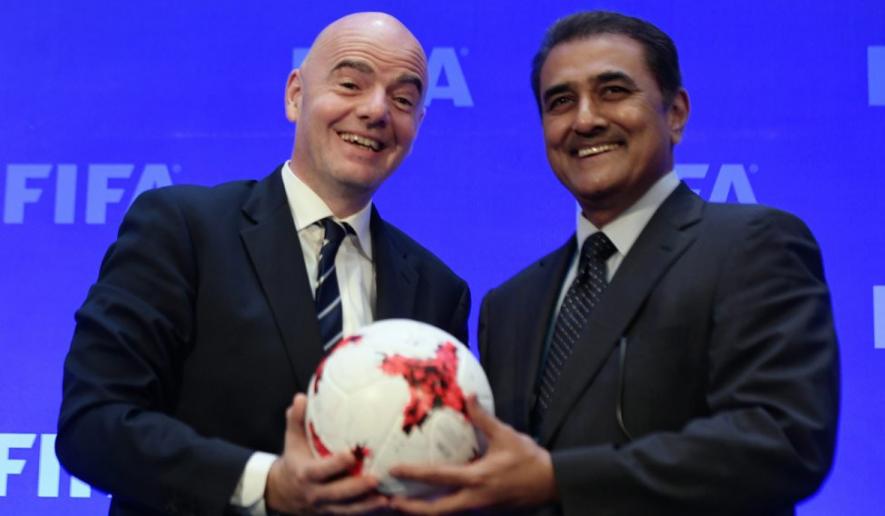India to Host 2020 U-17 Women’s World Cup; Indian Football Should Make it Count

India won the bid to host the FIFA U-17 Women’s World Cup 2020, the second such event India will host in the space of four years. (Pic: Twitter/AIFF)
In 1995, when Oinam Bembem Devi made her full debut for the Indian women’s senior football team she was 15 years old. The details of her debut match are sketchy enough — and badly recorded — to cause confusion on who the opponents were exactly on the day. Public records state Bembem’s debut came against Guam in the Asian Women’s Championship, but closer inspection will reveal India never faced Guam at the tournament at all. Bembem remembers her debut as having come up against Hong Kong with India recording a victory, but losing the rest of the games of the series.
In that story rests the innate paradox of India’s women’s football. There is much to admire and look up to, but very little to base it on.
India was recently awarded the hosting rights for the FIFA U-17 Women’s World Cup in 2020. It was a rare bit of good news the All India Football Federation (AIFF) has had this month — an administrative success for a federation mostly incapable of cleaning its own nose without messing up the plumbing.
Video | Hunt for Indian Football Team Coach: Celebrity Manager or Domestic Veteran
Much of this must be admired. If there is one thing and only one thing to be gained out of holding prestigious international events in a country it is the raised profile of the sport within its own masses. The experience and the exposure this event will give Indian women’s football is priceless.
Bembem acknowledges this.
“The federation must be commended for taking this step and bringing the tournament home. Let’s forget the players for a bit, and just say that this kind of tournament will awaken people to the reality of women’s football in India,” she says, her excitement barely contained on a dodgy phone line.
“I can’t believe that our young girls will get a chance to turn up at the World Cup, at a World Cup, my excitement is beyond limits. And I will admit, I am also a little jealous. We used to get a chance to play only qualifiers, but these girls will now have a chance to do something we couldn’t, and this is an opportunity to really make some serious noise,” she adds.
And the noise, she cautiously warns, must be positive and sustained. Bembem stresses on the need for everyone, the state units, the federation, the Sports Authority of India (SAI) as well as the ministry to come together to not just promote this team, but also create a sustainable blueprint for the future. The short term vision of wins and goals at the World Cup must be mixed with the necessity to make sure this keeps happening well after the FIFA bandwagon has pulled away.
Stepchild Treatment
It is this thought that dominates the entirety of Anadi Barua’s conversation when the World Cup is brought up.
“There is no benefit to just playing a World Cup, that is quite clear, I hope. If you are thinking of just playing a World Cup, and hosting the games in established urban centres, then the whole project is a fail,” he says.
Also Read | Indian Football’s Super Cup Drama: I-League Clubs Pull Out of Pull-Out
Barua, a former coach of the Indian women’s team, admits to a lack of interest harming the sport for girls and women across the country. The stepchild treatment hurts.
“All the stakeholders of Indian football must focus on incentivizing football for girls in the country. Not just as a game to play but as a profession to follow. For the men’s game — and right now I’m not comparing this sport to any other like cricket, mind you — there is a league system, where young players get exposure by playing with foreign players. There are monetary incentives for young players, and overall there is a firm developmental programme in place across age groups.”
When it comes to the women’s game, the national team is ranked 62nd in the world, 12th in Asia. But those numbers are only of academic interest for statistic junkies. At the human, development level, little has been firm and taken hold.
The Indian Women's League — a first for Indian football, a pan-India league for women — played its first season in 2016-17, and has had two seasons so far. The first included one team each fielded by both I-League (Aizawl FC) and the (ISL) Indian Super League (Pune City FC) , but neither team carried on after the first season.
There is no organised league structure at the junior level, and barring state departmental units, Police and the Railways, job opportunities for women footballers are few and far between. Even at the senior level, the Indian women’s team pops up in conversation only around the time a tournament comes around — as it is now, with the SAFF Championships — and as late as June last year, the senior team was starving for match time.
A football club owner confessed that there was very little incentive in launching a women’s team in Indian football’s current landscape. Refusing to be named, he admitted to attempting to put a team for the opening edition of the Women’s League but pulled out because of ‘organisational and financial difficulties’.
Video | I-League Review: Champions Chennai, Youthful Arrows and Real Kashmir Fairytale
At the end of the day, despite all the hyperbole about good of the sport and the beautiful game’s beautiful needs, everything boils down to the bottom line. And for Indian football, the bottom line bleeds.
“Maybe this is the big step needed to get everyone to work together and grow the sport. At the grassroots, of course, but most important is financially,” says Barua. “This is something even the ministry and SAI need to get behind. Not just promote the World Cup, but also football for girls in India. Establish training centres, maybe offer incentives for youth players through a stipend of some sort. Give them security. Make it worth their while.”
Money Matters
Barua also brings up a lot of other core issues surrounding women’s football — and women sport as a whole in India. It is an issue that is slowly becoming a major topic of discussion regarding the sport across the world. Financial growth.
Where the US Women’s team are vying for equal pay to their male counterparts, the rest of the world is still picking up the scraps off the men’s table. Women’s football recently created history, as Atletico Madrid and FC Barcelona recorded the highest attendance ever for a women’s game in the world, but that is a one off. The Women’s Super League is still played out to empty, second-tier stadiums across the UK. Most of the big clubs have a women’s team that share the sponsorship of the men’s but bring in next to nothing on their own.
A lot of this is blamed on the inability to think big when it comes to women’s football. A significant onus though must also be put on corporates who refuse to ‘think big’ and risk something for the sport.
In the immediate, though, Indian women’s footballing future is inextricably tied to the World Cup and so, success in it, or at least a positive outcome, is of utmost importance.
Barua confesses that despite the ‘great news’ of the World Cup coming to town, there needs to be significant work done at the grassroots for Indian football. In the immediate, he admits that the junior teams are very competitive at the SAFF level. A lack of exposure outside of this local realm is bothering.
Also Read | Chennai City FC’s Indian Football Journey: I-League Champions Now, Uncertainty Ahead
Bembem says that now is when the AIFF must look to send the team for exposure trips outside.
“I will definitely be recommending that they send the girls to play against stronger nations, get the exposure and the experience. They can hold series, do training camps, send individual players out if you must, all of it will benefit them,” she says.
Former International Ishfaq Ahmed admits that the lack of time, and the short term goals that the AIFF is culpable of, may mean that ‘they will have to get players who are ready to go right now, rather than have the potential to grow later.
“Unlike with the U-17 Boys World Cup, this time around, the time available to build a team and get ready to kit up is much lesser,” says Ishfaq. “With the boys they had an extensive scouting process, a renewed training process, camps, selection, and then isolation to build a team. This time around, they have to hit the ground running and select players who can keep up,” he adds.
Ishfaq’s ending words, though, are an echo of what should soon become a running mantra. “This is great, though, and should help grow the profile of the sport in the country. Young girls should be inspired looking at this event.”
At the recent I-League awards held in Chennai, AIFF General Secretary Kushal Das praised Chennai City FC’s triumph by focussing on the club’s ground-up work ethic. “Chennai City FC's triumph this season has been a true testament of their planning, strategising and execution,” he said.
What goes for a club, goes for a country. The World Cup is here. With just about a year to go and no grand pool to fish the players from, it’s time for India to think big and act fast.
Get the latest reports & analysis with people's perspective on Protests, movements & deep analytical videos, discussions of the current affairs in your Telegram app. Subscribe to NewsClick's Telegram channel & get Real-Time updates on stories, as they get published on our website.
























